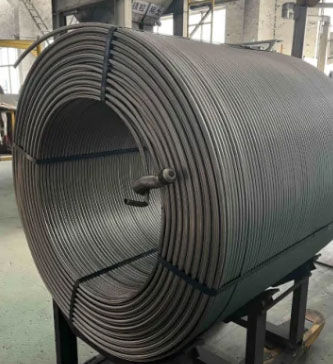
In the realm of steelmaking, continuous innovation is essential to meet the ever-increasing demands for higher quality and efficiency. One such innovation that has revolutionized steelmaking processes is cored wire injection. This technique involves the introduction of cored wires containing various alloying elements into the molten metal bath, offering numerous advantages over conventional methods. In this article, we explore the concept, applications, and benefits of cored wire injection in steelmaking.
Cored wire injection involves the use of a thin steel tube, known as a cored wire, filled with a powdered or granular alloying material. The cored wire is injected into the molten metal bath within the ladle or furnace, allowing the controlled release of alloying elements during the steelmaking process. The alloying elements, such as calcium, silicon, aluminum, and others, are encapsulated within the cored wire, ensuring precise and efficient delivery.
Alloying: Cored wire injection is widely employed for alloying purposes in steelmaking. The addition of alloying elements at the precise moment ensures homogeneous distribution and controlled reactions. This technique enables the production of specialty steels with specific properties, such as improved corrosion resistance, strength, and heat resistance.
Deoxidation and Desulfurization: Cored wire injection plays a vital role in the deoxidation and desulfurization processes during steelmaking. Cored wires containing elements like calcium and aluminum react with oxygen and sulfur impurities, respectively, forming stable compounds that can be easily removed from the molten metal. This results in cleaner steel with reduced inclusion content and improved mechanical properties.
Inclusion Modification: Cored wire injection offers the ability to modify the inclusions present in the steel. Certain cored wires, such as calcium wire, have a strong affinity for oxygen and sulfur, resulting in the formation of calcium-based inclusions. These inclusions can effectively trap harmful impurities, enhancing the cleanliness and quality of the steel.

Enhanced Control and Precision: Cored wire injection allows for precise control over the addition of alloying elements. The encapsulated alloying materials are released in a controlled manner, ensuring accurate and uniform distribution within the molten metal. This precise control leads to improved consistency in steel quality and reduces the risk of alloying element overdosing.
Increased Efficiency and Cost Savings: The targeted delivery of alloying elements through cored wire injection leads to increased efficiency in steelmaking processes. The direct introduction of alloying materials saves time and energy, reducing processing costs. Moreover, the ability to use smaller-sized cored wires minimizes material waste and provides cost-effective alloying solutions.
Improved Occupational Safety: Cored wire injection offers improved safety for operators compared to traditional methods. By eliminating the need for manual alloy additions, it reduces the risk of occupational hazards, such as exposure to high temperatures, fumes, and splashes. This enhances the overall safety standards in steelmaking facilities.
Cored wire injection has become a game-changer in the steelmaking industry, providing precise and efficient alloying solutions. Its applications in alloying, deoxidation, desulfurization, and inclusion modification contribute to the production of high-quality steel with improved properties. The benefits of enhanced control, increased efficiency, cost savings, and improved safety make cored wire injection an indispensable technique for modern steelmakers. As the industry continues to evolve, cored wire injection will continue to play a significant role in meeting the ever-growing demands of the steel market.

Write a Message